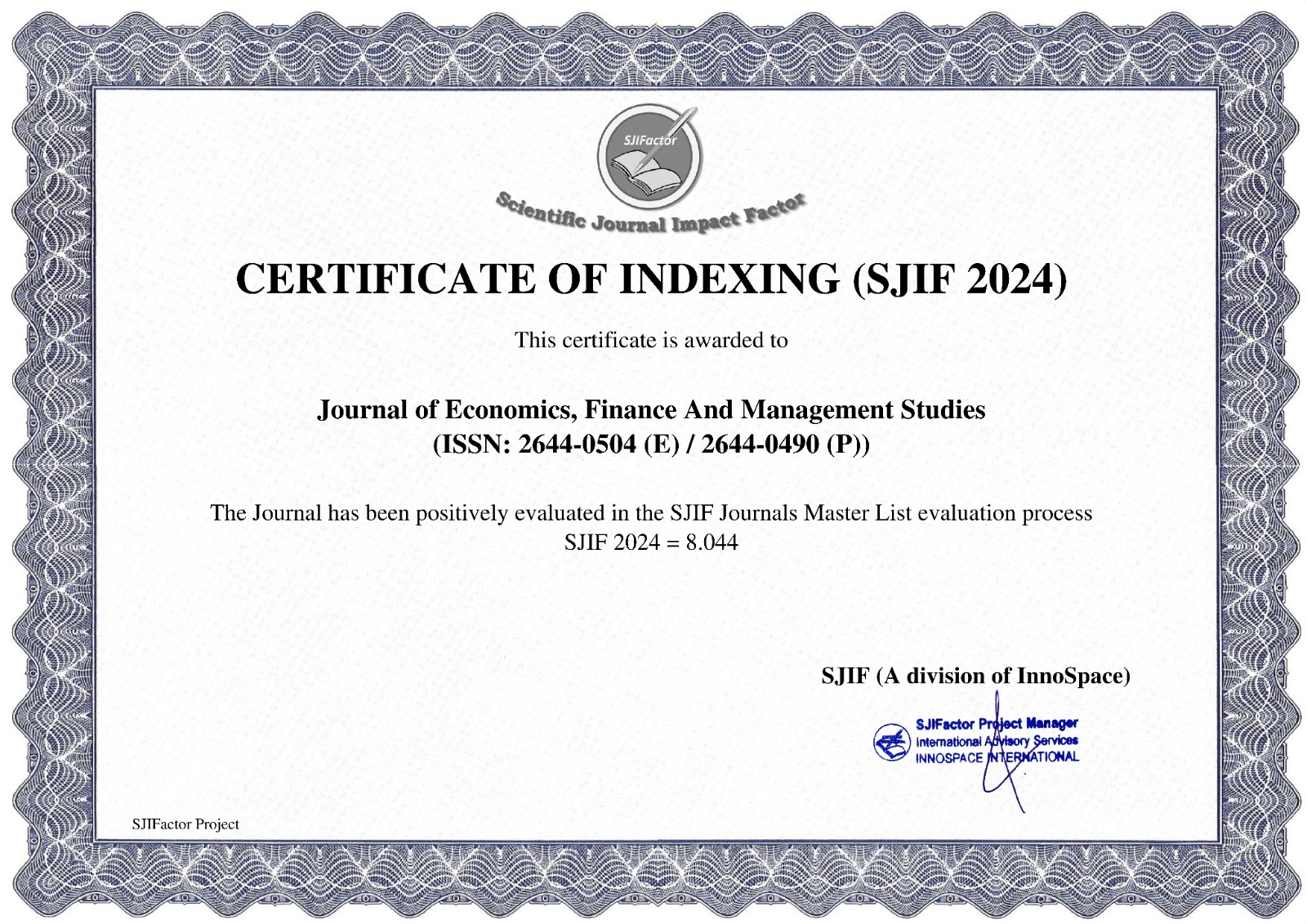Socio-Technical Integration in Digital Healthcare Distribution: An Ontological Framework of Contextually-Mediated Channel Efficacy
1Quoc Dung NGO, 2Tuan Vinh TRAN, 3Duc Anh HOANG
1,2Lecturer, Faculty of Planning and Development, National Economics University, Vietnam,
3Student, Faculty of Investment, National Economics University, Vietnam
https://doi.org/10.47191/jefms/v8-i3-14
ABSTRACT:
Purpose: This research advances an integrative framework for optimizing healthcare service distribution through digital channels by synthesizing service quality dimensions with contextually-mediated technology acceptance constructs. The study interrogates the differential efficacy of distribution channels across demographic and geographical contexts, with particular emphasis on the socio-technical determinants of sustainable channel adoption.
Research design, data and methodology: The investigation employs methodological triangulation through a sequential mixed-methods design. Initial qualitative exploration with seven domain experts informed the development of context-sensitive measurement instruments, subsequently validated through quantitative analysis of 295 users across diverse distribution regions of Vietnam. The study operationalizes a Socio-Technical Adaptive Channel Integration (STACI) framework through structural equation modeling with multi-group analysis capabilities, enabling dimensional comparison of distribution effectiveness across demographic and geographical boundaries.
Results: The empirical trajectory reveals pronounced asymmetries in channel effectiveness determinants, with service quality (β = 0.534, p < 0.001) and security protocols (β = 0.278, p < 0.001) emerging as dominant predictors of channel attitudes, substantially outweighing traditional usability factors. Multi-group analysis uncovers significant contextual variations in distribution effectiveness, with path coefficient differentials between urban and rural implementation contexts (∆β = 0.237, p < 0.05). The structural model demonstrates robust explanatory power, accounting for 51.3% of variance in channel attitudes and 63.4% in distribution system adoption intentions.
Conclusions: This research contributes to distribution theory by establishing the Socio-Technical Adaptive Channel Integration framework, which reconceptualizes distribution systems as context-dependent socio-technical networks rather than uniform service delivery mechanisms. The epistemic insights generate strategic implications for developing adaptive, segment-specific digital distribution architectures in healthcare service delivery, with particular relevance for addressing inequities in channel accessibility across diverse implementation contexts.
KEYWORDS:
Socio-technical integration, Context-sensitive distribution, Digital healthcare systems, Multi-contextual service networks, Adaptive channel dynamics.
REFERENCES:
1) Abdullah, M. Y., Almazayen, F. M., Hwaifr, M. H., Alkhatir, W. S., Albar, A. M., Abdullah, N. A., Almodrhim, F. F., Akmalov, S., Alqurayn, M. N., Al Muzarra, Q. I., & Alatawi, W. H. (2023). Effect of COVID-19 on chronic care management in primary health settings. International Journal of Community Medicine and Public Health, 11(1), 516–520.
2) AlQudah, A., Al-Emran, M., & Shaalan, K. (2021). Technology acceptance in healthcare: A systematic review. Applied Sciences, 11(22), 10537.
3) Andriopoulou, F., Birkos, K., Mantas, J., & Lymberopoulos, D. (2018). Software-defined networking for ubiquitous healthcare service delivery. Advances in Experimental Medicine and Biology, 12(2), 95-104.
4) Bailey, J. E., Gurgol, C., Pan, E., Njie, S., Emmett, S., Gatwood, J., Gauthier, L., Rosas, L. G., Kearney, S. M., Robler, S. K., Lawrence, R. H., Margolis, K. L., Osunkwo, I., Wilfley, D., & Shah, V. O. (2021). Early patient-centered outcomes research experience with the use of telehealth to address disparities: Scoping review. Journal of Medical Internet Research, 23(12), e28503.
5) Bond, A. (2023). Margin notes from the covid-19 pandemic for the future of healthcare innovation. Healthcare Management Forum, 36(6), 393-398.
6) Bustamante, A. V., Martínez, L. E., Jalal, S., Benitez Santos, N., Félix Beltrán, L., Rich, J., & Anaya, Y. B.-M. (2023). Racial and ethnic disparities in telehealth use before and after California's stay-at-home order. Frontiers in Public Health, 11, 1222203.
7) Catapan S de C., Haydon H. M., Hickman I.J., et al . (2023). Trust and confidence in using telehealth in people with chronic kidney disease: A cross-sectional study. Journal of Telemedicine and Telecare, 29(10), 16S-23S.
8) Chen, N., Liu, P., & Lv, P. (2022). Assessing elderly user preference for telehealth solutions in China: Exploratory quantitative study. JMIR mHealth and uHealth, 10(1), e27272.
9) Dhaliwal, J., Hall, T., Larue, J., Maynard, S., Pierre, P., & Bransby, K. (2021). Expansion of telehealth in primary care during the COVID-19 pandemic: Benefits and barriers. Journal of the American Association of Nurse Practitioners, 34(2), 224-229.
10) Duffy, L., Evans, R., Bennett, V., Hady, J., & Palaniappan, P. (2023). Therapeutic relational connection in telehealth: Concept analysis. Journal of Medical Internet Research, 25, e43303.
11) Filbay, S., Bennell, K., Morello, R., Smith, L., Hinman, R., & Lawford, B. (2022). Exploring experiences with telehealth-delivered allied healthcare services for people with permanent and significant disabilities funded through a national insurance scheme: A qualitative study. BMJ Open, 12(9), e065600.
12) Gately, M., Quach, E., Shirk, S., & Trudeau, S. (2022). Understanding variation in adoption of video telehealth and implications for health care systems. Medical Research Archives, 10(5).
13) Hair, J. F., Black, W. C., Babin, B. J., & Anderson, R. E. (2021). Multivariate data analysis (8th ed.). Cengage Learning.
14) Harris, M., & Rogers, W. (2021). Developing a healthcare technology acceptance model (H-TAM) for older adults with hypertension. Ageing and Society, 43(4), 814-834.
15) Jiang, Y., Sun, P., Chen, Z., Guo, J., Wang, S., Liu, F., & Li, J. (2022). Patients' and healthcare providers' perceptions and experiences of telehealth use in chronic disease management: A qualitative study. BMC Geriatrics, 22(1), 1-14.
16) Jungwirth, D., & Haluza, D. (2017). Information and communication technology and the future of healthcare: Results of a multi-scenario Delphi survey. Health Informatics Journal, 25(1), 161-173.
17) Leonard, C., Liu, W., Holstein, A., Alliance, S., Nunnery, M., Rohs, C., & Winchester, D. (2023). Informing use of telehealth for managing chronic conditions: Mixed‐methods evaluation of Telehealth Use to Manage Heart Failure During COVID‐19. Journal of the American Heart Association, 12(4), e027362.
18) Liu, W., Xia, Y., & Hou, J. (2019). Health expenditure efficiency in rural China using the super-SBM model and the Malmquist productivity index. International Journal for Equity in Health, 18(1), 1-12.
19) Martin, R., Mandrusiak, A., Lang, R., Forbes, R., & Russell, T. (2022). A telehealth curriculum: A pre-post study of physiotherapy students' perceived knowledge. Focus on Health Professional Education, 23(3), 56-72.
20) Milosevic, Z. (2020). Enacting policies in digital health: A case for smart legal contracts and distributed ledgers? The Knowledge Engineering Review, 35, e4.
21) Müller, S., Wehner, D., Konzag, H., Vesterby, M., & Høybye, M. (2021). The paradox of project success despite lack of the "my pathway" telehealth platform usage. Journal of Health Informatics, *27(*1), 1-12.
22) Orrange, S., Patel, A., Mack, W., & Cassetta, J. (2021). Patient satisfaction and trust in telemedicine during the COVID-19 pandemic: Retrospective observational study. JMIR Human Factors, 8(2), e28589.
23) Papalamprakopoulou, Z., Ntagianta, E., Triantafyllou, V., & others. (2024). Telehealth to increase healthcare access: Perspectives of people who use drugs. Research Square.
24) Qi, X., Mei, G., Cuomo, S., & Xiao, L. (2020). A network-based method with privacy-preserving for identifying influential providers in large healthcare service systems. Future Generation Computer Systems, 109, 293-305.
25) Schretzlmaier, P., & Hecker, A. (2022). Extension of the unified theory of acceptance and use of technology 2 model for predicting mHealth acceptance using diabetes as an example: A cross-sectional validation study. BMJ Health & Care Informatics, 29(1), e100640.
26) Sun, M., Ye, Y., Zhang, G., Shang, X., & Yang, X. (2023). Healthcare services efficiency and its intrinsic drivers in China: Based on the three-stage super-efficiency SBM model. BMC Health Services Research, 23(1), 1-15.
27) Takahashi, E., Schwamm, L., Adeoye, O., Alabi, O., Jahangir, E., Misra, S., & Still, C. (2022). An overview of telehealth in the management of cardiovascular disease: A scientific statement from the American Heart Association. Circulation, 146(25), e472-e486.
28) Thompson, T. L., Robinson, J. D., & Brashers, D. E. (2022). Interpersonal communication and health care (2nd ed.). Oxford University Press.
29) Truong, M., Yeganeh, L., Cook, O., Wong, P., & Allen, J. (2022). Using telehealth consultations for healthcare provision to patients from non-indigenous racial/ethnic minorities: A systematic review. Journal of the American Medical Informatics Association, 29(5), 970-982.
30) Wei, X., Xie, H., Peng, X., & Prybutok, V. (2020). An investigation of the consumer's trusting mechanism in emerging healthcare technology. Industrial Management & Data Systems, 121(2), 290-311.
31) Wiest, I. C., Sicorello, M., Yesmembetov, K., Ebert, M. P., & Teufel, A. (2024). Usage behaviour and adoption criteria for mobile health solutions in patients with chronic diseases in gastroenterology. Visceral Medicine, 40(2), 61-74.
32) Williams, H., Steinberg, S., Vingum, R., Leon, K., Céspedes, E., Berzin, R., & Hagg, H. (2023). Parsley health: Feasibility and acceptability of a large-scale holistic telehealth program for chronic disease care. Frontiers in Digital Health, 5, Article 1008574.
33) Zhu, L., Jiang, X., & Cao, J. (2023). Factors affecting continuance intention in non-face-to-face telemedicine services: Trust typology and privacy concern perspectives. Healthcare, 11(3), 374.
















